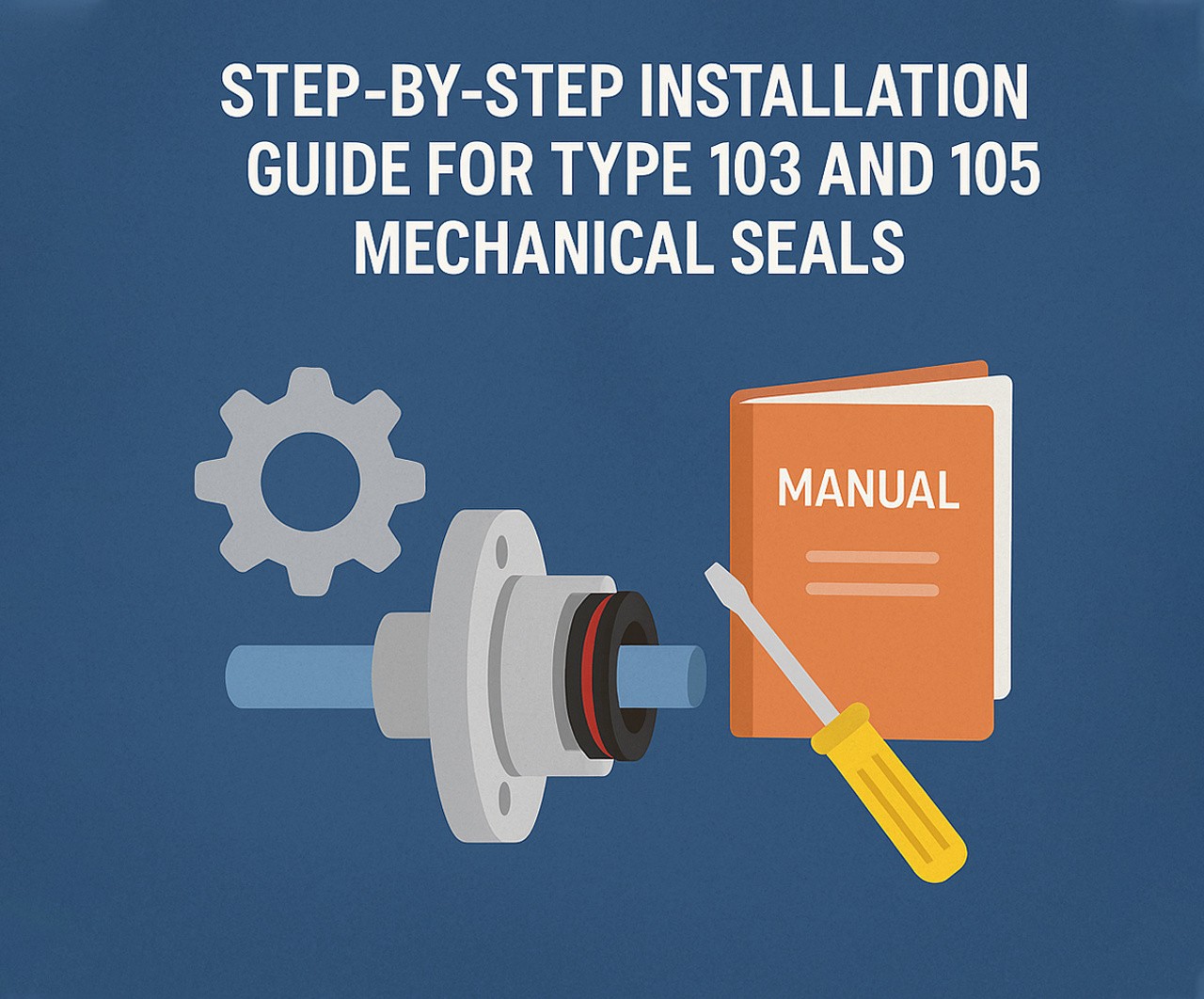Installing mechanical seals correctly is essential for maximizing equipment lifespan and minimizing downtime. Whether you’re working in food processing, wastewater treatment, or heavy industry, having a reliable mechanical seal supplier and knowing how to handle Type 103 Mechanical Seals and Type 105 Mechanical Seals can be the difference between seamless operation and repeated breakdowns. This comprehensive guide offers a step-by-step walkthrough on how to properly install both seal types, ensuring optimal performance and longevity.
With the right tools, the right seal, and guidance from a trusted mechanical seal supplier, even the most intricate seal installations can be executed smoothly. Let’s explore how to install Type 103 Mechanical Seals and Type 105 Mechanical Seals with care and precision. Know more..
What Are Type 103 and 105 Mechanical Seals?
Both Type 103 Mechanical Seals and Type 105 Mechanical Seals are single-spring, elastomer bellows seals commonly used in centrifugal pumps. While they share similar core design elements, they differ slightly in their applications and dimensional standards.
- Type 103 Mechanical Seals: These are standard-duty seals used in ANSI pumps and are ideal for water, light chemical, and general-purpose industrial use.
- Type 105 Mechanical Seals: Designed for OEM applications, these seals provide flexibility in installation and customization. They’re often used in submersible pumps, sump pumps, and small process equipment.
Both seals are easily sourced from a reputable mechanical seal supplier and are popular due to their affordability, versatility, and ease of replacement.
Tools and Materials You’ll Need
Before starting the installation of either Type 103 Mechanical Seals or Type 105 Mechanical Seals, ensure you have the following:
- Properly matched mechanical seal kit (verified by pump model and shaft size)
- Soft, lint-free cloths
- Isopropyl alcohol or seal-safe cleaner
- Calipers or micrometers (for shaft measurement)
- Torque wrench (if specified by OEM)
- Anti-seize or non-hardening lubricant
- Personal protective equipment (PPE)
Step-by-Step Installation: Type 103 Mechanical Seals
Step 1: Preparation
- Isolate and depressurize the system
- Disconnect power supply to the pump
- Drain all fluid from the pump and ensure clean work conditions
Step 2: Disassembly
- Remove the pump casing, impeller, and backplate as necessary
- Carefully slide the old seal components off the shaft
- Clean the shaft thoroughly using isopropyl alcohol and a soft cloth
Step 3: Inspect Components
- Check the shaft sleeve for scoring, grooves, or corrosion
- If any wear is detected, replace the sleeve or consult your mechanical seal supplier for alternatives
Step 4: Install the Stationary Seat
- Lubricate the outer diameter of the stationary seat
- Press the seat into the seal chamber using finger pressure only
- Use a plastic tool to seat it squarely without cracking the face
Step 5: Install the Rotary Unit
- Gently slide the bellows over the shaft
- Apply lubricant to aid movement but avoid contaminating the seal face
- Press the rotating face gently against the stationary seat
- Align set screws if provided and tighten evenly
Step 6: Reassemble Pump
- Replace impeller, backplate, and casing
- Tighten all fasteners to OEM torque specs
- Rotate shaft manually to ensure no resistance or misalignment
Step 7: Test and Monitor
- Restore system pressure and fill with fluid
- Run the pump dry for no more than 2 seconds to confirm rotation
- Observe for leaks, temperature anomalies, and vibrations
Step-by-Step Installation: Type 105 Mechanical Seals
Type 105 Mechanical Seals follow a similar procedure but are more commonly installed in OEM applications, where access and spacing may be limited.
Step 1: Confirm Compatibility
- Check that the seal fits your OEM pump specs exactly
- Measure the shaft and seal cavity using calipers
- Contact your mechanical seal supplier for custom modifications if needed
Step 2: Shaft and Chamber Cleaning
- Use a lint-free cloth and seal-safe cleaner to remove all debris
- Make sure there is no oil or chemical residue left on sealing surfaces
Step 3: Lubricate and Insert Stationary Seat
- Gently push the seat into the seal housing
- Use a flat plastic tool or install tool to seat it evenly
- Ensure the face is parallel to the shaft axis
Step 4: Slide on the Rotating Seal
- Apply lubricant to the shaft and inner bellows
- Carefully slide the rotating part of the seal along the shaft
- Make sure the spring compresses uniformly and doesn’t bind
Step 5: Alignment and Locking
- Align the rotating face and secure set screws or retaining clips
- Some Type 105 seals use snap-fit mechanisms instead of screws
- Verify rotation by hand for smooth movement
Step 6: Final Assembly
- Reconnect pump components
- Replace all gaskets or O-rings with new ones
- Tighten all bolts to proper specifications
Step 7: Commissioning
- Prime the pump with process fluid
- Slowly bring system up to full speed
- Monitor for at least 30 minutes during initial operation
Best Practices for Long-Term Seal Performance
Regardless of seal type, here are universal tips to prolong mechanical seal life:
- Source Quality: Work with a trusted mechanical seal supplier to ensure authenticity and performance.
- Never Dry Run: Always ensure fluid is present before starting the pump.
- Monitor Vibration: Excess vibration shortens seal life and leads to premature failure.
- Seal Face Care: Never touch the seal face with bare fingers.
- Routine Inspection: Schedule regular checks for signs of wear or misalignment.
Common Mistakes to Avoid
- Over-tightening set screws: Can warp the rotating face
- Contaminated seal faces: Can cause immediate leakage
- Wrong seal selection: Always verify with your mechanical seal supplier
- Improper lubrication: Leads to dry spots and overheating
When to Replace Instead of Repair
Mechanical seals do wear out, even with perfect installation. Signs that it’s time for replacement include:
- Persistent leakage
- Visible scoring or cracking on the seal face
- Excessive vibration or noise
- Discoloration or melting due to overheating
Consult with your mechanical seal supplier for refurbishment options or seal upgrades to extend the life of your equipment.
Final Thoughts: Precision Over Speed
Installing Type 103 Mechanical Seals or Type 105 Mechanical Seals isn’t just about getting the pump running again—it’s about making sure it stays running. By following these detailed steps and working closely with a qualified mechanical seal supplier, you can extend your seal’s life, reduce downtime, and protect your equipment investment.
Every detail matters—from cleaning the shaft to aligning the seal face. Whether you’re working in a high-pressure refinery or a mid-sized municipal pump station, choosing and correctly installing the right mechanical seal will always pay off in performance and peace of mind.
Remember, seals don’t just stop leaks—they start reliability.


